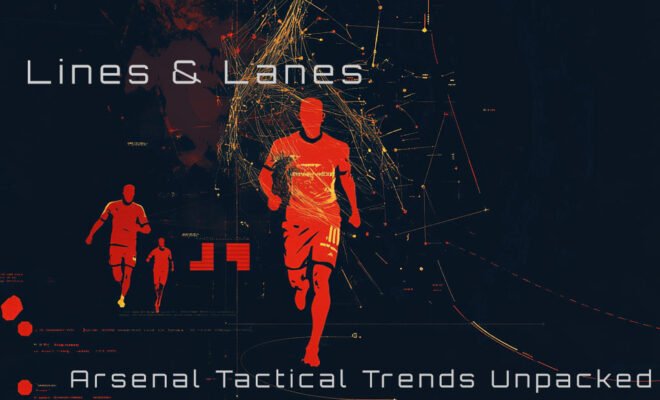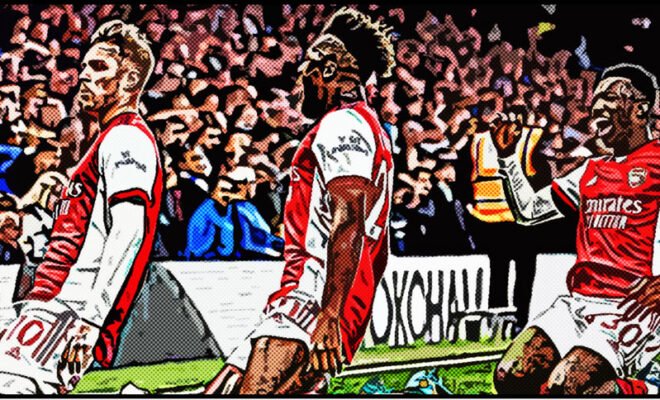Arsenal After Six Matches: Defensive Reliability, New Creativity, and the Next Step

Arsenal’s league campaign is no longer in its feeling-out phase. The narrow opening win at Old Trafford signaled a team comfortable managing tense away minutes. Leeds at home revealed the ceiling when possession and pressing are fully synchronized. Anfield reminded that control alone doesn’t guarantee results when margins tighten. Forest and Manchester City reinforced the defensive platform that travels against any opponent. At Newcastle, Arsenal added another statement away win, shaped by set-piece precision, non-shot value, and calm territorial control.
Across these first six games, the team looks less like one experimenting and more like one refining. The defensive system is built to last, the possession structure has become a reliable tool to neutralize different styles, and the attack is slowly diversifying. Yet some familiar issues remain: central penetration, striker output against top defenses, and the risk of relying on a few creative leaders when games get tough.
Trends That Continued
Right-sided progression as the primary engine
Arsenal’s build-up is still anchored on the Ødegaard, Saka, White and Timber axis. This is no passing fad; it is a codified pattern. The touch maps and passing networks show that even when personnel changes (White for Timber, Madueke for Saka), the structure holds. Against Newcastle, even in a brief cameo, Ødegaard repeatedly dropped into the half-space to knit play, while Saka received under pressure and still found ways to deliver cut-backs. Timber’s overlaps provided the third-man option. Opponents know the pattern but have not found an easy solution because the rotations, underlaps, overlaps, and half-space overloads, remain sharp.
Possession as a defensive and attacking weapon
The control is not just sterile. Arsenal use long, composed spells to limit counter-attacks and tire opponents. At Newcastle, field tilt and touch maps showed nearly 60 percent of play happening in advanced zones even without huge shot volume. Against City, the same approach starved Haaland of service; at Anfield it muted Liverpool’s press even if Arsenal created little. Rice and Zubimendi orchestrate the rhythm, one dropping to collect, the other stepping past the first line when space opens, while the creative midfield choices pull defenders to create wide overloads. This blend of circulation and patience is now a core game-state tool.
Defensive base remains elite and portable
The Gabriel and Saliba partnership is still the spine. Saliba’s reading of long balls and Gabriel’s front-foot dueling cut off transitions, while Raya’s sweeping prevents isolation. Mosquera’s cameos when Saliba was absent did not collapse the structure, a critical test passed. The numbers support it: not one opponent has produced more than 1.0 non-penalty xG, and Newcastle managed almost nothing central. Arsenal defend high when safe, drop into a mid-block when needed, and have kept wide-to-central switches from becoming dangerous.
Set-piece threat as a consistent edge
Few teams weaponize dead balls like Arsenal. Calafiori’s match-winner at Old Trafford, Timber’s brace against Leeds, and a cleverly designed goal at Newcastle (dragging markers to free space near post) underline how varied their playbook is. Wide free kicks are aimed to isolate Gabriel or Calafiori; corners have multiple triggers (short outswingers, back-post floods). In a season where open-play finishing can run hot and cold, these routines are worth real points.
Full-back asymmetry gives both balance and unpredictability
The right-back (Timber or White) regularly pushes to join or create the overload, while Calafiori on the left holds or joins late (or vice versa). This structure provides a safe rest-defense shape but can still surprise, as seen with Calafiori’s late-arriving goal in Week 1 and his progressive surges versus Newcastle. The principle has been constant across six games and underpins both control and counter-press resilience.
Newly Emerging Trends
A left side that now matters
Early weeks saw the left as a quiet support lane; now it is an active progression channel. Calafiori is braver stepping infield, Rice often drifts wide to combine, and Eze adds 1v1 threat plus cut-backs. At Newcastle, the left half-space accounted for a near-equal share of final-third entries. This keeps opponents from overloading the central zone and forces more honest defending.
Midfield pivot growing into playmakers
Rice’s switches, disguised forward balls, and goal probability added (GPA) have ticked up each week. Zubimendi, once just a stabilizer, now breaks lines with first-time passes and has added a scoring threat (brace vs Forest). At Newcastle, both registered multiple progressive passes and key box entries. The pivot is no longer just a shield; it is a springboard.
Adaptable pressing and block management
Arsenal can now morph mid-match. Against Leeds and Forest, they pressed high to suffocate buildup (PPDA around 8). Against City and at Anfield, they protected space in their typical compact 4-4-2 mid-block. At Newcastle, they mixed, jumping triggers when the ball went wide but staying conservative in central build-up zones. This modulation reflects maturity and coaching clarity.
Non-shot value as a scoreboard weapon
Field tilt and possession maps at St. James’ Park showed Arsenal creating xThreat through territory, deep completions, and box access even without huge shot totals. They are becoming a team that can accumulate advantage without always racking up 20 shots, a key skill in tight away matches.
Squad depth impacting tactics, not just minutes
The currenrly injured Madueke brings a dribbling-first look when Saka rests or is limited. Eze provides ball progression and creation from the centrally or from the left. Mosquera covered Saliba without breaking the line. Youth players like Lewis-Skelly and Nwaneri have helped maintain compact midfield spacing late in matches. The rotation pieces are not just filling gaps; they are changing the look of matches.
Concerning Trends
Central chance creation bottleneck persists
Despite added left-side play and midfield creativity, zone 14 remains under-utilized. Newcastle, City, and Liverpool all forced Arsenal wide, where crossing and cut-backs lack variety. Without sharper central combos, quick wall passes, and third-man runs, elite blocks can reduce shot quality.
Gyökeres still looking for a big-game breakthrough
The striker links well now, dropping and connecting play, but his penalty-box shot volume against top defenses is low. Leeds and Forest saw his movement rewarded; Anfield, City, and Newcastle kept him quiet in high xG areas. Arsenal need him to convert territorial dominance into goals against elite back lines.
Reliance on top creators when absent
When Ødegaard or Saka sit, attacking clarity fades. The Anfield loss exposed this most; Newcastle was better, but still hinged on set pieces and deep completions rather than open-play incision. Until new signings deliver in marquee games, creative burden remains top-heavy.
Finishing volume and variance risk
The Leeds 5-0 flattered underlying numbers (five goals from around 2.9 xG). Since then, Arsenal’s shot counts have been modest, and finishing has cooled. Matches against City and at Newcastle were decided by narrow swings; the margin for error remains slim.
Wing duels under pressure
United and Liverpool tilted wide duels; City and Newcastle challenged here too. When Saka or Timber lose those battles, progression stalls. Improving 1v1 success or diversifying entry methods such as third-man runs and rotations will be key.
Reinforced Positives
Elite defensive record across contexts
Six matches, almost no high-value chances conceded. Arsenal can suppress danger whether playing deep at Anfield, controlling home vs Leeds, or away at Newcastle or against a resurgent City. Few sides play week in, week out with this kind of defensive reliability.
Pressing flexibility delivers outcomes
They have won territory through high turnovers (Leeds, Forest) and neutralized elite build-ups with calm mid-blocks (City, Anfield). Opponents have not yet found a predictable weak point.
New signings raise the ceiling
Madueke adds verticality; Eze drives a creative threat; Zubimendi mixes control with goals; Gyökeres pins defenses and helps link play. These are functional, match-impacting upgrades.
Game-state management has matured
Arsenal can build, strike, and then control matches. Increasingly, once they gain an advantage, they manage possession and defensive structure to close games out with calm, organized play.
Conclusion — A Platform Ready for Bigger Tests
Six games show a team with one of the league’s most reliable defensive systems, a possession model that adapts to context, and a set-piece playbook worth real points. Arsenal’s right side is still the heartbeat but no longer the only idea; the left now matters, the midfield can create, and depth is real.
The next step is clear: transforming control into higher-value central chances and consistent striker impact against top opponents. If Gyökeres starts finishing those small-window chances and Rice and Zubimendi keep adding line-breaking value, Arsenal’s current control can translate into decisive wins even when variance swings.
This is not a side searching for an identity; it has one. The question is whether the added layers of creativity and finishing power will arrive in time to turn control into a title run.






